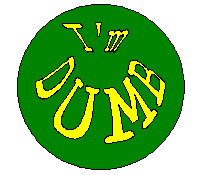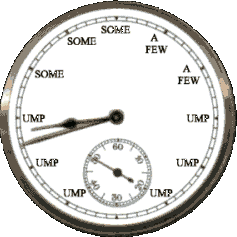
Issue number 1
Installed: 01-5-2000
Campaigning for you
![]()

How often do you use the term umpteen when you are unsure of an exact quantity? The question must be asked, what value should we place on umpteen?
It is self explanatory that it most probably lies within the range 10-20, as this is the range which includes the -teen numbers. This does ignore the possibility of it referring to one hundred and n-teen, &c., which would satisfy the -teen requirement, but this is really a compound number, and in my experience, it is normally reserved for smaller quantities.

When we consider the word umpteen, it is obviously derived from the same root as any other -teen. That is, it is a number between 0 and 10, plus 10. As in six+te(e)n. This implies that ump must be a number less than 10.
Why, when referring to a low quantity, do we say "a few"? This implies a very low number. The use of ump would not limit us in this manner, and this is the basis of this campaign.
We must make use of ump, and also its other derivatives, umpty, umpillion, &c. The only known use made in literature is actually a nursery rhyme telling of a horrific accident which befell a rather fragile gentleman, and the impossibility of reconstructive surgery afterwards. In this, it refers to the number of pieces he broke into. The work is of course "Umpty Dumpty".
Campaign badges are available emblazoned with our acronym ("I'm DUMB") but are inexplicably unpopular. Feel free to save the button logo to produce your own badges.
![]()
 |
 |
 |
|---|
![]()
If you have any bandwagons for us to jump on, please e-mail to .